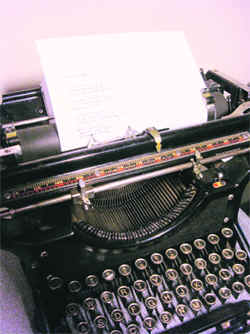Not all of us are proficient at the keyboard. Since my initiation into the world of computers was on a Mac and not a DoS machine, the most painful things about learning how to use the computer was to learn how to type. I had no formal training, and had to learn from Tarsem Singh, who was a trained steno-typist.
 He could not find work similar to what he had done in India before he migrated to New York. He thus changed his job and was a building superintendent when I met him. It was under his tutelage that I practiced my ‘Quick Brown Fox…’, and to him I owe my ability to type at a reasonable speed.
He could not find work similar to what he had done in India before he migrated to New York. He thus changed his job and was a building superintendent when I met him. It was under his tutelage that I practiced my ‘Quick Brown Fox…’, and to him I owe my ability to type at a reasonable speed.
I used an electric typewriter to practise, and like most users, learnt on the typical QWERTY keyboard, which was designed by Christopher Latham Sholes in 1873 for the Sholes and Glidden typewriter. Remington bought it the same year, and since then it has been the standard for all Remington typewriters. The keyboard is named after the first six characters in the far left of its top row of letters.
The main reason for designing this layout of keys was to prevent the typebars of various letters from clashing with each other as the typist typed them. We have all seen such typewriters, and can still see them outside courts and other such institutions.
Now, in the case of computers, the original reasoning did not hold good because of change of technology, but since this was the standard keyboard, most people continue with it, especially since the jury is still out on whether alternatives give very significant advantages.
There is, however, truth in the statement that since when the QWERTY keyboard was designed, the primary requirement was to prevent jams while typing fast. Thus, decisions on the layout of keys were taken to distance commonly used pairs of letter, and this, in effect, slowed down typing.
While the Dvorak Simplified Keyboard is considered technically superior and easier to learn, there are very few keyboards that use it. However, you can map it in many computers, using a special mode setting. The Dovark keyboard, however, has a small, devoted and vocal following. It is not too small, over a lakh at least, but not big enough to have any impact.

The latest buzz these days is Google Instant, a new search enhancement that shows results as you type. It uses Google’s “black magic” algorithms to offer predictions based on what you type, and as you input more letters, the predictions become better. Google had gone to town on the time saved, which is measured in nanoseconds for many of us, and no matter what the hype is, I really don’t see how these nanoseconds add up to a discernable saving of time.
Now saving effort is another thing and that’s where Instant really scores! Since the predictive mode works reasonably well, we can scroll down the choices and our query to the search engine faster. For slow typists, such predictive help is a tangible gain.
All of us who use mobile phones have got used to the T9, named after the nine keys available for inputting data on a mobile phone. Nokia, LG, Samsung, Siemens, Sony Ericsson, Sanyo, Sagem and many others use this system, which has rivals like Motorola’s iTap. BlackBerry’s SureType is a system that combines a traditional phone keypad with the computer-type QWERTY-based keyboard quite innovatively.
What about computers? In my expanding search for ways to avoid typing every word, I visited the site that often gives us answers – Google! Their ongoing efforts to improve their performance have resulted in various experiments, which have been performed in Google Labs. The Google Scribe feature is described by Google as ‘a text completion service’. Using information from what you have already typed in a document, Google Scribe provides related word or phrase completion suggestions. In addition to saving keystrokes, Google Scribe’s suggestions indicate ‘correct’ or ‘popular phrases to use’.
I typed out the preceding paragraph in Google scribe, and in spite of a reasonably fast Internet connection, I found that I was typing much faster than the Scribe, which was offering alternatives. Tarsem Singh had taught me too well!
When I slowed down, I realised that around 50 per cent of the options were the correct ones, just what I wanted. I also found it distracting. While I opted against it for the moment, there is no doubt in my mind that it will be refined more and at some time in the future, I would be using it.
I am sure that it will be of major help when used on mobile phones, even for those youngsters whose thumbs seem to have specially evolved for typing on those small keypads. As technologies evolve, so do we…of course, our demands increase, too, and that spurs additional effort to meet them. I love having a ringside seat in this fast-paced electronic evolution, don’t you?
This article by Roopinder Singh was printed in the Lifestyle section of The Tribune on September 14, 2010
